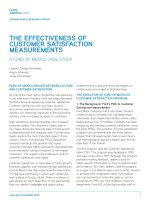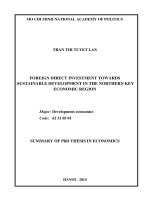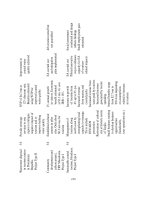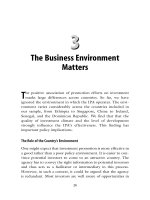world bank the effectiveness of promotion agencies at attracting foreign direct investment phần 9 ppt
Bạn đang xem bản rút gọn của tài liệu. Xem và tải ngay bản đầy đủ của tài liệu tại đây (83.75 KB, 12 trang )
Annex: FIAS-MIGA Questionnaire / 97
I – EXTERNAL ASSISTANCE
Table 21:External assistance projects (please check box)
Period during which
you received assis- Currently
Technical Financial tance(since date providing
Organization assistance assistance of establishment) assistance
World Bank []
FIAS []
MIGA []
UNDP []
UNIDO []
UNCTAD []
Regional development banks []
European Union []
WAIPA []
Bilateral donors []
Others (please specify) []
98 / The Effectiveness of Promotion Agencies
J – COMMENTS
If you wish to provide comments on some of the questions, or
specific information on your agency not covered by the questionnaire,
please feel free to provide them here (maximum 3,000 characters). [ ]
99
Notes
1. Wells, Louis, and Alvin Wint. 1990. Marketing a Country: Promotion
as a Tool for Attracting Foreign Investment. FIAS Occasional Paper, num-
ber 1. Foreign Investment Advisory Service, Washington, D.C.
2. Spar, Debora. 1998. Attracting High Technology Investment: Intel’s
Costa Rican Plant. Washington, D.C: Foreign Investment Advisory
Service.
3. www.cepici.go.ci, www.apix.sn., www.investir-au-niger.org.
4. UNCTAD. 2001. “The World of Investment Promotion at a Glance:
A Survey of Investment Promotion Practices.” United Nations
Conference on Trade and Development, United Nations Advisory Studies
number 17, UNCTAD/ITE/IPC/3.
5. Although the literature on this issue is limited, a number of bench-
marking studies have been undertaken. Some of these have been by con-
sultants for IPAs and are private documents as part of IPAs’ own develop-
ment process. Others, though less rigorous, are more public and have
been used as the basis for presenting awards for the best agency of the year,
such as that awarded by Euromoney.
6. The only empirical examination of the impact of FDI promotion on
FDI flows is Wells and Wint (2001). This study had shortcomings in terms
of the concept used to measure promotion. See: Wells, Louis and Alvin
Wint. 2001. Marketing a Country, Revisited. FIAS Occasional Paper,
number 13. Foreign Investment Advisory Service, Washington, D.C.
100 / The Effectiveness of Promotion Agencies
7. The FIAS/MIGA questionnaire used for this survey is in Annex A,
and the main responses can be found in the statistical appendix.
8. Although 64 percent of the agencies report some kind of evaluation
mechanisms, mainly consisting of actually monitoring the number of proj-
ects approved or registered by the agencies, only a handful of them collect
information on realization of investments, jobs created, exports generated,
and so forth.
9. These two motivations are sometimes referred to as vertical and hor-
izontal FDI. For a good summary on these views, see: Brainard, S. L.,
1997. “An Empirical Assessment of the Proximity-Concentration Trade-
off Between Multinational Sales and Trade.” The American Economic
Review 87(4):520–44.
10. Of course, abrupt changes in IPA budget are always possible as a
result of budgetary crises in government or the termination of external
assistance. However, these events occurred in a very few countries of our
sample, hence we believe that they will not significantly affect our empiri-
cal results that capture trends across a sample of 58 countries.
11. The full dataset is not available for all 75 IPAs included in our sur-
vey, because we were able to collect complete budget information for only
58 countries.
12. We used alternative investment climate indicators commonly used
in the literature such as World Economic Forum, International Country
Risk Guide, and so on. The results were similar but more robust (in terms
of explanatory power) with the Heritage Index. This index captures 50
independent variables divided into 10 broad factors of economic freedom
related to internal and external macroeconomic conditions, economic
openness, and political and institutional conditions. The higher the score
on a given factor, the worse the quality of the investment climate.
13. Our simulation assumes that one and only one IPA increases its
promotion effort at a given time. It is possible that if all IPAs (or at least
several of them) increase their budgets simultaneously, the resulting
impact on FDI flows would be negligible. The main concern is that the
various agencies may end up in a bidding war that results in a “prisoner’s
dilemma” that benefits the foreign firms at the expense of the winning
agency. This view of the world assumes, however, that the overall FDI
flows are fixed worldwide and that agencies only compete for their redis-
tribution.
Notes / 101
14. Since the IPA budgets vary greatly depending on the level of
income in the country, we tested if effectiveness is significantly different
between high-income countries and the rest of our sample. We find that
the association between the IPA budgets and FDI is higher for non-high-
income countries (the elasticity is equal to 0.29 compared to 0.25 for the
full sample).
15. We employ a kernel or neighborhood function to estimate the rela-
tionship. This method is adaptive and dynamic in the sense that the slope
parameter changes along the regression curve depending on the location
of the variables in the sample. More specifically, we minimize the weight-
ed sum-of-squared errors between the actual and the fitted by allowing the
program to compute a regression at every point in our dataset. A kernel
fit is superior to the regression analysis because the latter assumes con-
stancy of the slope parameters.
16. Such initial external assistance has proved to be used in the early
stages of the development of the IPA in Cape Verde, Costa Rica, the
Dominican Republic, and Honduras.
17. In general, support from the private sector can come in one of three
forms: direct contributions to an agency’s capital base or budget, payment
for specific services, or the provision of staff resources for use by IPAs.
18. For a detailed discussion on the limitations of private funding for an
IPA, see: FIAS. 1999. “Strengthening Investment Promotion Agencies:
The Role of the Private Sector.” Washington, D.C. Processed.
19. Heller, P.S. 1975. “A Model of Public Fiscal Behavior in
Developing Countries: Aid, Investment, and Taxation.” American
Economic Review 65(3):429–45.
20. Note this underestimation problem is more apparent for the
investor-services and investment-generation functions because they are
directed to specific investors, sectors, or both. The image-building and
policy-advocacy functions have a more general aim and thus are expected
to influence overall FDI flows, beyond the IPA’s direct responsibility.
21. Indeed, as recently confirmed by Batra and Moody (2002), varia-
tions in cross-country FDI flows are well explained by these factors over
the past decade. The Heritage Index captures 50 independent variables
divided into 10 broad factors of economic freedom related to internal and
external macroeconomic conditions, economic openness, and political and
institutional health. The higher the score on a given factor, the greater the
102 / The Effectiveness of Promotion Agencies
level of government interference in the economy and the less economic
freedom a country enjoys. The index assigns scores inversely to the state of
the investment climate; hence we expect a negative sign on the coefficient
of the estimation.
22. Since our data are cross-sectional, we use the White consistent
covariance matrix estimator to estimate the coefficient covariances in the
presence of heteroskedasticity of unknown form.
23. Note that in principle, this lag problem would be minimized by
using the approved FDI projects in our regressions because there is a min-
imal lag between the promotion effort and the approval decision.
24. As defined by the ranking of the Heritage Index in our sample of
countries.
25. The example cited here is to demonstrate the techniques we used
to test for thresholds and external conditions’ influence on IPA effective-
ness. Our example assumes that the sample of countries is divided into two
subcategories but we actually tested alternative numbers of subcategories
(2, 3, 4, and 5) and threshold values in our empirical application. We also
explored thresholds using quadratic and square root equations.
26. In this case we weight the promotion effort by the actual index
value of the investment climate rather than using a dummy variable. In
doing so, we have the advantage of not having to choose arbitrary thresh-
old values for our dummy variables, but we must assume a stable relation-
ship between the IPA effectiveness and the investment climate.
27. As defined by the lowest ranking of the Heritage Index in our sam-
ple of countries.
28. While these categories are useful, and help structure our analytical
work, they present a few limitations. First, it is not always easy to separate
all activities performed by agencies and some overlapping can be observed
in the survey. For instance, when an agency makes a presentation to a
group of investors, it may perform an image-building and possibly an
investment-generation activity. Second, even if this conceptual framework
is well known today, the degree of familiarity varies across agencies.
29. We observe that poorer countries tend to spend a smaller portion on
investor facilitation (27 percent) than richer ones (35 percent), which
makes sense given the labor intensity of this function and differences in the
human resources available between countries. Further, in percentage terms,
poorer countries tend to spend more on image building than rich countries,
Notes / 103
34 percent and 22 percent, respectively. However, when absolute values are
taken into consideration, rich countries’ expenditures in this area are still
five times higher on average. Developed countries also spend a larger per-
centage of total budget on the investment generation function (36 percent
versus 29 percent in developing countries), which is not surprising since
activities associated with this function are costly and can require highly spe-
cialized skills. Both groups spend roughly the same percentage on policy
advocacy despite the fact that OECD policy framework tends to be signif-
icantly better.
30. We used the approach described in the preceding chapter for the
overall IPA budget, but apply it to each IPA function. Unfortunately,
these series of tests were nonconclusive in depicting any significant cross-
country differences in the estimated impact of each IPA function.
31. Wells and Wint (1990).
32. A negative but weak correlation of –0.27 is depicted between the
quality of the investment climate and the share of the IPA budget allocat-
ed to policy advocacy.
33. The average for developed countries surveyed stands out as a group
with a significantly higher figure, 6,155 per year.
34. Note that this category, implementation, is typically included in pre-
investment activities among many IPA experts. We separated this category
in our survey to gain a more detailed understanding of activities under-
taken in this area, as well as resources allocated.
35. This calculation takes average amount spent on contacts by devel-
oping countries (US$186,196) and developed countries (US$1,905,000)
and divides each by the average number of investors contacted for each
group.
36. An agency with one private representative would report an elastic-
ity coefficient equal to 0.22, while an agency with eight private sector
representatives in its board will see its effectiveness increase to about
0.32.
37. From our survey, we found out that agencies report to prime min-
isters or presidents through alternative mechanisms; a few report to a
board of directors that is chaired by the prime minister or the president,
while others report only to the prime minister or president. We did not
find any significant differences between these two reporting mechanisms
in our statistical analysis.
104 / The Effectiveness of Promotion Agencies
38. Both do require business skills, and each can support the other.
Successful investment promotion is likely to lead to an increase in exports.
And successful export promotion can well lead to investment as buyers
integrate backwards to control their sources.
105
Index
administrative practices, 41
advertising, 15–16, 38–39, 64
age, 46, 58
agency, 54
autonomy, 49
budget, 54, 62, 100n.10,
100n.13, 101n.14
allocations, 34
contacting investors,
42–43
elasticity, 13, 23
image building, 38, 62
investment generation, 62
investor services, 39, 62
policy advocacy, 36–37, 62
region, by, 14
size, 4, 5, 14–16
stability, 11
business environment, 10,
24–31
coordination, 9
role, 24–25
technical appendix, 29–31
coordination activities, 17
cross-country variation, 2,
101–102n.21
data analysis
business environment,
29–31,
102–103nn.22–25
effectiveness, 18–23,
100n.8
internal characteristics,
52–53, 103nn.34–36
IPA functions, 44,
102–103nn.26–30,
103nn.32, 33
development level, 25–27
DUM, 29
106 / The Effectiveness of Promotion Agencies
effectiveness, 8–23, 27, 55
comparison, 26
external variables and, 30
measuring, 9–12
technical appendix, 18–23
elasticity coefficients, 26, 31,
103n.36
EV, 19, 52
evaluation, 100n.8
expenditures, 15
export and investment promo-
tions, 50, 60
external aid, 17, 101n.16
external variables, effectiveness
and, 30
FDI, 18–20, 52
definitions, 20
FDI flows, 26, 27, 31, 55
approved projects, 20, 21
elasticity, 35
gross, 20–21
investment generation and,
40–41
IPA characteristics and, 53
mergers and acquisitions,
20–21
policy advocacy and, 36
variation, 2, 101–102n.21
vertical vs. horizontal,
100n.9
fees, 17
financial commitment, 16–17,
54–55
findings, key, 4, 12–13
funding sources, 16
government, 16–17
GDP, number of mandates
and, 48
government funding, 16–17
human resources. See staff
IC, 30
image building, 6, 7, 25,
32–33, 38–39, 101n.20
budget, 38, 62
implementation, 103n.34
incentives, 40, 61
income per capita, 4
information, communication
and dissemination, 9,
24–25
activities, 17
packages, 38
inquiries per year, 64
institutions
features, 58
forms, 59
links, 55
internal characteristics, 45–53
technical appendix, 52–53
investment climate, 13, 55,
100n.12
poor, 27, 29
investment generation, 6, 7,
32, 33, 35, 40–43,
102–103n.29
budget, 62
Index / 107
activities, 65
program features, 42
underestimation, 101n.20
investment promotion, useful-
ness, 9
investment promotion agen-
cies (IPAs), 1–2, 12–13,
50, 61, 104n.38
activities, 55
analytical justifications, 9
characteristics, 45–53, 55
developing country, 5
effectiveness, 10
establishment, 8
functions, 7, 32–44
inflow and, 53
percentage of total budget,
34
ranking by function, 32–35
study approach, 11–12
study questions, 2–3
study source, 2
technical appendix, 44
typical, 47
investor facilitation, 7,
102–103n.29
investors
contacted, cost, 42–43,
103n.35
number, 43
domestic, 37
investor services, 6, 7, 32, 33,
39–40, 65
budget, 39, 62
preinvestment, 39, 40
postinvestment, 39
underestimation, 101n.20
kernel function, 101n.15
legal status, 45–46
management, commitment,
50–51
mandates, 50, 51
number assigned, 48
market, local, size, 10–11
mode of creation, 59
neighborhood function,
101n.15
one-stop shops (OSSs), 41
overseas offices, 46, 50
PE, 18–19, 30
policy advocacy, 6, 7, 33, 34,
35, 36–37, 101n.20
activities, 66
budget, 36–37, 62
FDI inflow and, 36
policy recommendations,
54–55
policymakers, choices, 27–28
political visibility, 6
postinvestment services, 39
preinvestment activities, 39,
40, 103n.34
presence abroad, 46, 50
private entities, 14
108 / The Effectiveness of Promotion Agencies
private sector, 36, 48, 50,
101n.17
contributions, 17
participation, 6
privatization, 61
project implementation, assis-
tance, 39
promotion, 49
agency, 54
FDI and, 13–14
role, 4–5
staff, 63
testing, 44
promotional material, produc-
tion, 38
public entities, 14
public events, 38
public relations, 38
questionnaire, 67–98
development, 56
responses, 57
reporting mechanisms, 47–48,
49, 55, 60, 103n.37
responsibility, prime, 61
sample, 12
scope of activities, 5–6
size, 15–16
specialists, 42
spending, FDI and, 3
staff, 13, 14–15, 47, 50
promotion, 63
qualification, 63
statistical appendix, 56–66
strategic sectors, 14
study limitations, 54
survey, 37, 56–57
task forces, government-led,
37
utility function, 18
wages, 47
Web hits per year, 64









